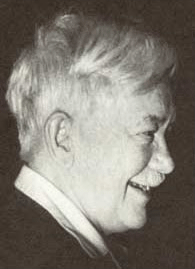William Addison Dwiggins coined the term in 1922 to describe his work in book design, illustration, typography and calligraphy, although the term did not achieve widespread usage until after WWII.
William Addison Dwiggins (June 19, 1880 Martinsville, Ohio – December 25, 1956 Hingham, Massachusetts ) was a U.S. type designer, calligrapher, and book designer. He attained prominence as an illustrator and commercial artist, and he brought to the designing of type and books some of the boldness that he displayed in his advertising work.
His typefaces—Electra and Caledonia are most widely used—were specifically designed for Linotype composition and have the clean spareness of the motor age. Metro is most notable as his most modern sans serif typeface. Metro was developed by Linotype in the late 1920s in response to similar type being sold from European foundries such as Futura, Gill Sans, and Erbar.
His scathing attack on contemporary book designers in An Investigation into the Physical Properties of Books (1919) led to his working with the publisher Alfred A. Knopf. A series of finely conceived and executed trade books followed and did much to increase public interest in book format. Dwiggins was perhaps more responsible than any other designer for the marked improvement in book design in the 1920s and 1930s. He gained recognition as a calligrapher and wrote much on the graphic arts, notably essays collected in MSS by WAD (1949), and his Layout in Advertising (1928; rev. ed. 1949) remains standard.
WAD (as he called himself) is credited with coining the term ‘graphic designer’ in 1922[1] to describe his various activities in book design, illustration, typography, lettering and calligraphy (his first typeface designs were released much later). The term did not achieve widespread usage until after the Second World War.
Dwiggins’ love of wood carving led to his creation of a marionette theatre in a garage (.5 Irving Street) behind his home in Hingham, Massachusetts (30 Leavitt Street), and a puppet group named the Püterschein Authority. In 1933 he performed his first show there, “The Mystery of the Blind Beggarman.” Dwiggins built his second theatre under his studio at 45 Irving Street. Further productions of the Püterschein Authority included “Prelude to Eden,” “Brother Jeromy,” “Millennium 1,” and “The Princess Primrose of Shahaban in Persia.” Most of his marionettes were twelve inches tall.[2] The marionettes were donated to the three-room Dwiggins Collection at the Boston Public Library in 1967.[3]
1 Typefaces
Metroblack – 1928
Electra – 1935
Caledonia – 1938
Charter – 1946
Hingham (not released)
Experimental 267D (not released)
Eldorado – 1953
Falcon
Stuyvesant
Arcadia
Tippecanoe
Winchester
Metro Sans
2 Bibliography
An Investigation into the Physical Properties of Books – 1919
Layout in Advertising – 1928
Towards a Reform of the Paper Currency, Particularly in Point of its Design – The Limited Editions Club, 1932
Form Letters: Illustrator to Author – William Edwin Rudge, 1930
Millennium 1 – Alfred A. Knopf, 1945
3 Books illustrated or designed
The Complete Angler, Izaak Walton – Merrymount Press, 1928
Paraphs, Hermann Püterschein – Alfred A Knopf for the Society of Calligraphers, 1928
The Lone Striker, Robert Frost – Alfred A. Knopf, 1933
Beau Brummell, Virginia Woolf – Rimington & Hooper, 1930
The Witch Wolf: An Uncle Remus Story, Joel Chandler Harris – Bacon & Brown, 1921
The Type Designs of William Addison Dwiggins.
In her short biography of William Addison Dwiggins, Dorothy Abbe, his close associate during his last years, begins by telling us what a nice man he was. A man who took his work very seriously but himself lightly, he was by all accounts a pleasure to work with.
Born in Ohio in 1880, Bill Dwiggins studied art in Chicago, and by 1904 had settled, for life as it turned out, in Hingham, Massachusetts, to pursue his career.
In his early years, Dwiggins did most of his work in advertising. And in 1928, he wrote Layout in Advertising. It was considered the standard text on the subject, so much so that the book was reissued twenty years later.
His heart was in the making of books, however, and this led him to strive to improve the generally poor quality of trade books in America. Believing that the advent of the machine was in no way incompatible with artistic excellence, Dwiggins set about devising methods to use the new technology to artistic advantage.
He devised a system of ornamentation by which small or large designs could be constructed from the series of small decorative units he cut as stencils. But he wanted most to be remembered for type design, and he was a prodigious producer in that area. He designed five marketed typefaces: Metroblack/Metrolite, Electra, Caledonia, Eldorado and Falcon. Of ten other incomplete faces, five were used experimentally in books in the 12-point pilot size.
Dwiggins received honorary membership in Boston’s Society of Printers and the Double Crown Club in London, the AIGA medal, an honorary degree from Harvard University and appointment as a Fellow of the American Academy of Arts and Sciences.
Bill Dwiggins relieved the pressure of work by building a miniature theater, complete in every detail, featuring a cast of magnificent twelve-inch marionettes that he carved of wood with the consummate skill with which he approached all artistic endeavors. The marionette theater, together with his typographical work and other forms of his art, now resides in the Boston Public Library, where three rooms are devoted to the Dwiggins Collection.
In the last two years of his life, Dwiggins’s failing health made it impossible to work any longer, but his good humor never deserted him. He said, “It was a grand adventure; I am content.”
William Addison Dwiggins died at his home on Christmas Day, 1956.
Please note: Content of biography is presented here as it was published in 1979.
Source: Team 39, Wikipedia, The Art Directors Club.
Quoted
Limitations and distractions are hidden blessings


